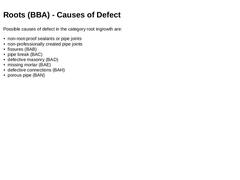
|
Possible causes of defect in the category root ingrowth are: -
non-root-proof sealants or pipe joints
-
non-professionally created pipe joints
-
fissures (BAB)
-
pipe break (BAC)
-
defective masonry (BAD)
-
missing mortar (BAE)
-
defective connections (BAH)
-
porous pipe (BAN)
|
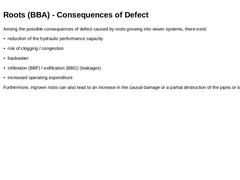
|
Among the possible consequences of defect caused by roots growing into sewer systems, there exist: -
reduction of the hydraulic performance capacity
-
risk of clogging / congestion
-
backwater
-
infiltration (BBF) / exfiltration (BBG) (leakages)
-
increased operating expenditure
Furthermore, ingrown roots can also lead to an increase in the causal damage or a partial destruction of the pipes or structures. |
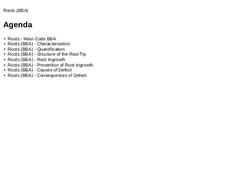
|
|
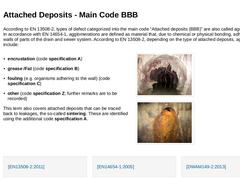
|
According to EN 13508-2, types of defect categorized into the main code “Attached deposits (BBB)” are also called agglomerations. In accordance with EN 14654-1, agglomerations are defined as material that, due to chemical or physical bonding, adheres to the walls of parts of the drain and sewer system. According to EN 13508-2, depending on the type of attached deposits, agglomerations include: |
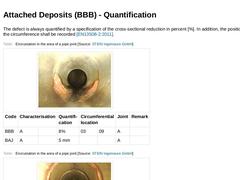
|
The defect is always quantified by a specification of the cross-sectional reduction in percent [%]. In addition, the position of defect at the circumference shall be recorded [EN13508-2:2011]. (Table: Encrustation in the area of a pipe joint) (Table: Encrustation in the area of a pipe joint) (Table: Encrustation in the area of a connection) |
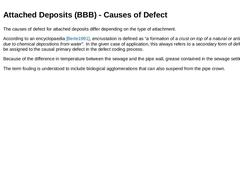
|
The causes of defect for attached deposits differ depending on the type of attachment. According to an encyclopaedia [Berte1991], encrustation is defined as “a formation of a crust on top of a natural or artificial object due to chemical depositions from water”. In the given case of application, this always refers to a secondary form of defect that shall be assigned to the causal primary defect in the defect coding process. Because of the difference … |
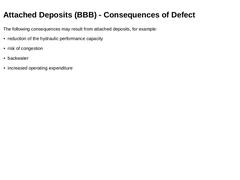
|
The following consequences may result from attached deposits, for example: |
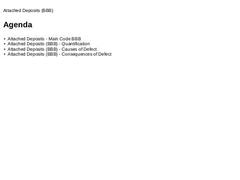
|
|
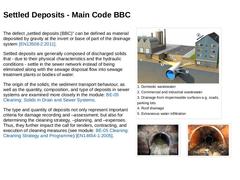
|
The defect „settled deposits (BBC)" can be defined as material deposited by gravity at the invert or base of part of the drainage system [EN13508-2:2011]. Settled deposits are generally composed of discharged solids that - due to their physical characteristics and the hydraulic conditions - settle in the sewer network instead of being eliminated along with the sewage disposal flow into sewage treatment plants or bodies of water. The origin of the solids, … |
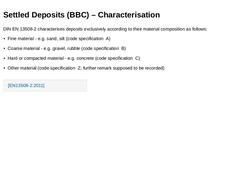
|
DIN EN 13508-2 characterises deposits exclusively according to their material composition as follows: -
Fine material - e.g. sand, silt (code specification A)
-
Coarse material - e.g. gravel, rubble (code specification B)
-
Hard or compacted material - e.g. concrete (code specification C)
-
Other material (code specification Z; further remark supposed to be recorded)
|
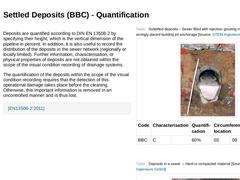
|
Deposits are quantified according to DIN EN 13508-2 by specifying their height, which is the vertical dimension of the pipeline in percent. In addition, it is also useful to record the distribution of the deposits in the sewer network (regionally or locally limited). Further information, characterisation, or physical properties of deposits are not obtained within the scope of the visual condition recording of drainage systems. The quantification of … |
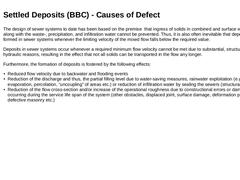
|
The design of sewer systems to date has been based on the premise that ingress of solids in combined and surface water sewers along with the waste-, precipitation, and infiltration water cannot be prevented. Thus, it is also often inevitable that deposits are formed in sewer systems whenever the limiting velocity of the mixed flow falls below the required value. Deposits in sewer systems occur whenever a required minimum flow velocity cannot be met … |
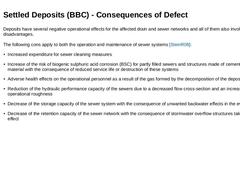
|
Deposits have several negative operational effects for the affected drain and sewer networks and all of them also involve economic disadvantages.
The following cons apply to both the operation and maintenance of sewer systems [SteinR08]: -
Increased expenditure for sewer cleaning measures
-
Increase of the risk of biogenic sulphuric acid corrosion (BSC) for partly filled sewers and structures made of cement-bound material with the consequence of reduced …
|
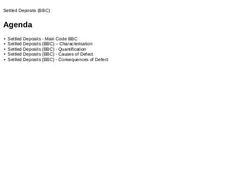
|
|
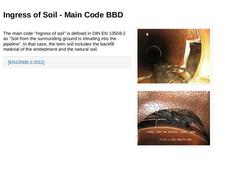
|
The main code "Ingress of soil" is defined in DIN EN 13508-2 as "Soil from the surrounding ground is intruding into the pipeline". In that case, the term soil includes the backfill material of the embedment and the natural soil. (Image: Pipe break – Missing wall segment and cavity visible ) (Image: Ingress of Soil (BBD) in the area of the pipe joint ) |
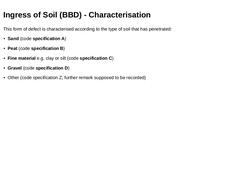
|
This form of defect is characterised according to the type of soil that has penetrated: -
Sand (code specification A)
-
Peat (code specification B)
-
Fine material e.g. clay or silt (code specification C)
-
Gravel (code specification D)
-
Other (code specification Z; further remark supposed to be recorded)
|
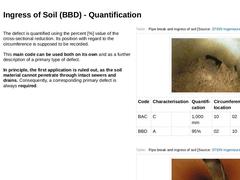
|
The defect is quantified using the percent [%] value of the cross-sectional reduction. Its position with regard to the circumference is supposed to be recorded.
This main code can be used both on its own and as a further description of a primary type of defect.
In principle, the first application is ruled out, as the soil material cannot penetrate through intact sewers and drains. Consequently, a corresponding primary defect is always required. |
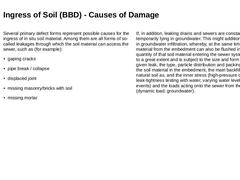
|
Several primary defect forms represent possible causes for the ingress of in situ soil material. Among them are all forms of so-called leakages through which the soil material can access the sewer, such as (for example): If, in addition, leaking drains and sewers are constantly or temporarily lying in groundwater. This might additionally result … |
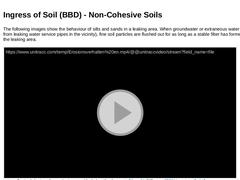
|
The following images show the behaviour of silts and sands in a leaking area. When groundwater or extraneous water infiltrates (e.g. from leaking water service pipes in the vicinity), fine soil particles are flushed out for as long as a stable filter has formed on top of the leaking area. (Video: Erosion behaviour of non-cohesive ground for leaks) |
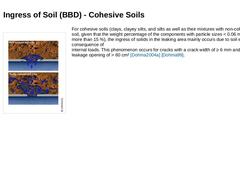
|
(Image: Erosion behaviour of cohesive ground for leaks with reference to [Jones84a] [Image: S&P GmbH])For cohesive soils (clays, clayey silts, and silts as well as their mixtures with non-cohesive types of soil, given that the weight percentage of the components with particle sizes < 0.06 mm amounts to more than 15 %), the ingress of solids in the leaking area mainly occurs due to soil erosion as a consequence of
internal loads. This phenomenon occurs … |
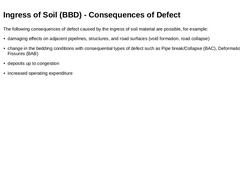
|
The following consequences of defect caused by the ingress of soil material are possible, for example: -
damaging effects on adjacent pipelines, structures, and road surfaces (void formation, road collapse)
-
change in the bedding conditions with consequential types of defect such as Pipe break/Collapse (BAC), Deformation (BAA), or Fissures (BAB)
-
deposits up to congestion
-
increased operating expenditure
|
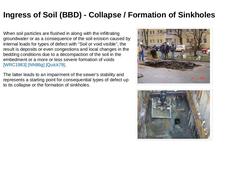
|
When soil particles are flushed in along with the infiltrating groundwater or as a consequence of the soil erosion caused by internal loads for types of defect with “Soil or void visible”, the result is deposits or even congestions and local changes in the bedding conditions due to a decompaction of the soil in the embedment or a more or less severe formation of voids [WRC1983] [NN86g] [Quick79]. The latter leads to an impairment of the sewer’s stability … |
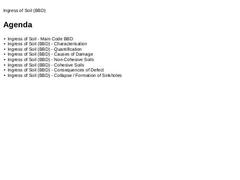
|
|
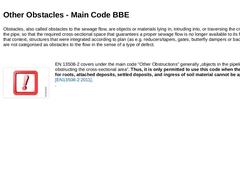
|
Obstacles, also called obstacles to the sewage flow, are objects or materials lying in, intruding into, or traversing the cross-section of the pipe, so that the required cross-sectional space that guarantees a proper sewage flow is no longer available to its full extent. In that context, structures that were integrated according to plan (as e.g. reducers/tapers, gates, butterfly dampers or backflow traps) are not categorised as obstacles to the flow … |
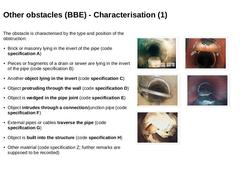
|
The obstacle is characterised by the type and position of the obstruction: -
Brick or masonry lying in the invert of the pipe (code specification A)
-
Pieces or fragments of a drain or sewer are lying in the invert of the pipe (code specification B)
-
Another object lying in the invert (code specification C)
-
Object protruding through the wall (code specification D)
-
Object is wedged in the pipe joint (code specification E)
-
Object intrudes through a …
|